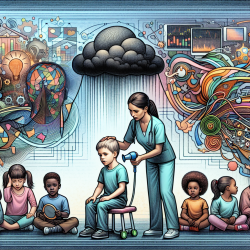Introduction
In the field of speech-language pathology, especially when working with children, accurate diagnosis and intervention are crucial. The recent research article, "Differentiating Psychosomatic, Somatopsychic, Multisystem Illnesses and Medical Uncertainty," provides valuable insights into the complexities of diagnosing conditions that intersect between physical and mental health. This blog explores how practitioners can apply these findings to improve diagnostic accuracy and outcomes in pediatric therapy.
Understanding the Complexities
The study highlights the challenges in distinguishing between psychosomatic, somatopsychic, and multisystem illnesses. These conditions often present with overlapping symptoms that can lead to misdiagnosis. For speech-language pathologists, understanding these distinctions is vital, as misdiagnosis can lead to inappropriate therapy strategies that do not address the root cause of a child's difficulties.
Key Findings and Their Implications
- Psychosomatic Disorders: These are physical symptoms exacerbated by mental stress. Recognizing the psychosomatic contributors in speech and language disorders can help tailor interventions that address both psychological and physiological aspects.
- Somatopsychic Disorders: Physical illnesses causing mental health symptoms. In children, this might manifest as anxiety or behavioral issues stemming from undiagnosed physical conditions, such as hearing loss or neurological disorders.
- Multisystem Illnesses: Conditions affecting multiple body systems, often requiring a multidisciplinary approach. Speech-language pathologists should collaborate with other healthcare professionals to ensure comprehensive care.
- Medical Uncertainty: The study emphasizes the importance of acknowledging uncertainty in diagnoses. Practitioners should remain open to revisiting and revising diagnoses as new information becomes available.
Practical Applications for Practitioners
To enhance diagnostic precision, practitioners should consider the following strategies:
- Thorough Assessment: Conduct comprehensive evaluations that include both speech-language assessments and screenings for potential psychological and physical health issues.
- Interdisciplinary Collaboration: Work closely with pediatricians, psychologists, and other specialists to develop a holistic understanding of the child's condition.
- Continuous Education: Stay informed about the latest research and advancements in both speech-language pathology and related fields to improve diagnostic accuracy.
- Patient-Centered Approach: Engage with families to understand the child's history and symptoms fully, ensuring that interventions are tailored to the child's unique needs.
Encouraging Further Research
The complexities highlighted in the study underscore the need for ongoing research into the intersections of physical and mental health in pediatric populations. Practitioners are encouraged to participate in or support research efforts that aim to refine diagnostic criteria and intervention strategies.
To read the original research paper, please follow this link: Differentiating Psychosomatic, Somatopsychic, Multisystem Illnesses and Medical Uncertainty.










